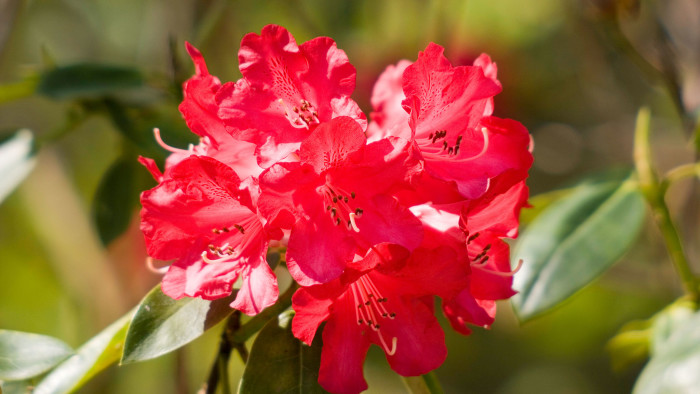Gardens: how to plant above a dig-down basement

Simply sign up to the Life & Arts myFT Digest -- delivered directly to your inbox.
If my career as a garden designer should falter, I have a new business venture up my sleeve. I’m going to start an enterprise renting out building site hoardings. Not to construction companies or developers, but to homeowners feeling left out because, during the current proliferation of redevelopments in central London, their home is one of the few on the street not to “have the builders in”.
London isn’t the only city in the thrall of an extensive rebuild, of course – I’m thinking big here, almost certainly going international with the hoarding rental in Q3 of year 2 – but it’s my “manor” and the place where I do most of my work. And, increasingly, that work involves gardening over a basement extension.
For a number of years local authority planners in London have taken a hard line against extending the footprint of buildings above ground in an attempt to prevent the green bits in between the brown bits being built over. It is hard to argue against the spirit of this thinking; cities are made more bearable by plants, and not just the green spaces in the public domain. A private garden can have just as much amenity value to the local area as a public planting, especially if that garden has trees in it, and they are visible from outside the boundaries of the garden. Gardens also enable storm water to drain away gradually rather than hurtling off to the nearest main drainage system. And planners also seek to preserve the aesthetic of the city, and as so many of the most desirable parts of London are also the most heavily protected by listing and conservation orders, externally visible modifications and additions are frowned upon. So we dig down, with some of the more extravagant basement extensions equivalent to or even exceeding the extent of the property above ground.

There are some interesting technical challenges to gardening over a basement extension. Loading is one, although thankfully this is within the remit of the structural engineer, as is the onerous responsibility of waterproofing. With modern technology you would think that keeping a basement watertight should be straightforward enough but tales of leaking ceilings and seeping walls are not uncommon. What is left at the end of a basement construction is a concrete bunker to garden over. This is not normal gardening though: every element is tightly controlled by the requirements of the structure, as much as (or even more than) the needs of the plants.
The need to keep the dig-out as lean as possible means that soil depth is often limited. Planning authorities usually insist on 1,000mm as a minimum requirement although sometimes there is much less to play with. Unlike in open ground, where rain and irrigation water can slowly percolate away through the soil, an over-basement garden will have a drainage system to take excess water away, which adds another layer of complication – blocked drains do not augur well for basements.

Perhaps the biggest complication of all is the soil itself. The soil in a “terrestrial” garden will in general be comprised of layers of subsoil and topsoil with varying amounts of organic matter, air, minerals, trace elements and nutrients. The age-old task for the gardener has been to take these raw materials and improve them, usually by adding more organic matter to improve the structure and drainage and unlock the potential of the soil as a growing medium. Over-basement gardens rely on a very different type of growing medium – the manufactured soil. As the name implies, these are soils that are man-made and created through a blending process that mixes the various ingredients together to create a uniform, homogenous product with prescribed characteristics. To anyone gardening on thick, orange clay with the drainage potential of blancmange in winter and a tendency to turn to concrete in summer, the idea of such an even and easy soil will sound close to horticultural heaven.

If the science behind the soil isn’t right, the whole scheme can fail. Tim O’Hare Associates is one of the leading practitioners of soils science in the UK – the consultancy was responsible for the specification of the soils at the 2012 Olympic Park. O’Hare has plenty of experience in specifying soils for over-basement gardens, and the potential pitfalls. One of those is the relationship between topsoil and subsoil depths. It would be tempting to think that, with just 1,000mm of soil depth to play with, the best way to obtain good plant growth would be to fill the full depth with topsoil. But, as O’Hare points out, most healthy soils in temperate climates (with a few exceptions, such as fenland soils) have a topsoil depth in the range of 150mm to 300mm. At these depths the soil retains an active microbe population and has a high biochemical oxygen demand.

The deeper the topsoil, however, the greater the risk of the development of anaerobic conditions, which can be harmful both to plants and the beneficial soil microbes. For the uninitiated, anaerobic soil is immediately and unforgettably recognisable by its smell; similar to that of an old and well-worn pair of damp woollen socks left sealed in a plastic bag for a few weeks. A topsoil depth of around 400mm for planted areas, and 200mm to 400mm for lawns, with the difference made up with subsoil is more likely to maintain healthy, balanced conditions. Drainage through both the subsoil and topsoil is vital, especially for plants that resent having their roots permanently moist, which include some of the most popular city garden plants, Taxus baccata (yew) and Buxus sempervirens (boxwood). Increasing the sand content of topsoil and subsoil can improve drainage potential, keeping the soil more open.
Manufactured soils offer the gardener almost endless opportunities to manipulate pH. Although pH can vary through a terrestrial garden, the range is usually fairly modest, but with imported soil over a basement it is possible to specify acid soils in one location, and alkaline in the next, provided a barrier exists between the two. Of course there is nothing new to this; gardeners have been manipulating soil pH and lime content for centuries. With manufactured soils the levels of exactitude are way beyond a bit of tinkering with peat and aluminium sulphate. The result is that plants can be planted side by side that would never be found together in nature, with a level of contrivance that throws up some aesthetic quandaries. Just because it is technically possible, is it right to have Sino-Himalayan woodland edge plants cheek by jowl with sun-loving Mediterranean sub shrubs? And although soil composition plays a critical role in plant health, the atmospheric moisture content needs of those two groups of plants are polar opposites – so however “right” the soil might be, it doesn’t necessarily follow that the plants will thrive.
The trend towards basement digs is showing no signs of slowing down, even when local authorities impose huge planning fees such as the £825,000 Section 106 levy charged by Kensington and Chelsea council over a domestic basement dig last year.
So, for now, it is fair to assume that the over-basement garden will continue to be a feature too. For those not wanting to dig, I can do a very nice line in hoardings.
——————————————-
Matthew Wilson is managing director of Clifton Nurseries, London
Comments